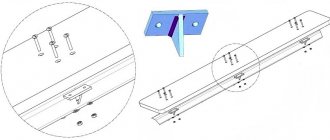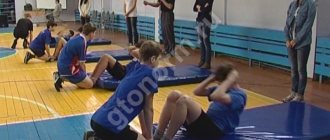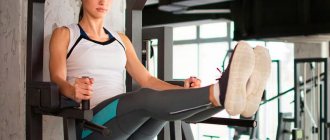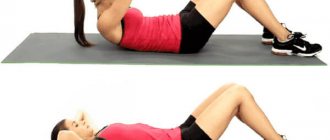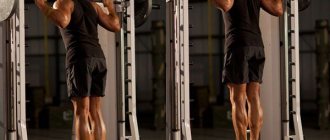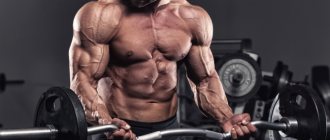Among women of all ages, the multifunctional strength trainer Roman chair is in great demand, thanks to which you can perform crunches and improve the mobility of the spine, making the abdominal muscles more prominent. This sports unit allows you to perform various physical exercises to thoroughly work out all muscle groups of the back, abdomen, and thighs. In this case, the weight of the training person is used as a burden.
Structure made of profile pipes
Let's try to figure out how to make a Roman chair with your own hands. First of all, you need to decide on the type of structure; it can be metal or wood. The first option is more reliable and aesthetic, and the second is easier to manufacture and budget-friendly.
To assemble a simulator from profile pipes, you need to draw up or select a suitable drawing. At the same time, the dimensions of the structure can be changed in accordance with your wishes and the anatomical characteristics of the athlete. However, it is important to maintain the proportions of the product and ensure its stability and reliability.
To work, you will need a hacksaw or grinder, an electric drill, and a screwdriver. In addition, a master cannot do without knowledge of the basics of metal cutting and welding. If such knowledge is not available, then it is advisable to order the design parts from pipe suppliers already cut. And the parts of the product can be fastened using screws.
When the dimensions of the future simulator are determined, you need to calculate the required amount of materials. The master will need:
- Standard steel pipes, preferably square, with a cross section of 50x50x4 mm. The main parts of the structure are made from them:
- a stand, which is assembled from two pipes 500 mm long and one pipe 1000 mm, located between the first two pipes;
- stand for footrest (length – 350 mm);
- support for the back (its length is equal to the length of the board);
- stand for the back (its length is determined by the degree of inclination of the board and is calculated taking into account the fact that the height of the top point of the structure is 700 mm from the floor).
- Wooden board for seat. The recommended size is 130x30 cm. For maximum ease of use of the chair, the board can be upholstered with leatherette, placing foam rubber or fabric under it. In this case, the seat should not be too soft.
- Round tube for foot rolls, approximately 390-400 mm long: 170+170 (length of two rolls) + 50 (width of the post to which the support tube is attached). The pipe must be covered with foam rubber and leatherette, and then attached perpendicular to the base of the structure.
- Fastening elements: screws, nuts and fasteners ensuring the connection of the seat with the support pipe. It is recommended to make fastenings from rectangular and triangular plates by welding. They are welded to a pipe that serves as a support for the seat, and then the back of the chair is attached to them using screws and nuts. All other parts of the product can be connected to each other by welding or using metal corners, screws and nuts.
If the chair is made correctly, it will last for many years, but such a product will not be the cheapest. It is only slightly inferior in price to a ready-made simulator. If a master wants to make a truly budget product, then it is better for him to give preference to a wooden structure.
Advanced Ab Bench
It differs from the usual one in that it has a board tilt regulator. The design should be equipped with comfortable leg clamps. To make a homemade simulator, it is recommended to make a drawing and perform calculations. You will need to purchase the following material:
Initially, a frame is constructed from square pipes
. A pipe 110 cm long is laid on the floor, and pieces of pipes 50 cm long are welded across the edges. A stand 26 cm high is attached to one end, and several holes are made in it for bolts.
Next you need to make a part in the shape of a “T”
", but with a slightly smaller pipe diameter so that the product fits tightly into the rack. It is also necessary to make holes in it, but to coincide with the holes on the stand, this is how you can adjust the leg part.
the next stand is installed 50 cm from the foot edge
30 cm in height. From this rack, at 33 cm, another one is mounted at 35 cm in height. Then you need to make holes in the 30-centimeter rack every 5 cm, but before making them, it is recommended to put a piece of pipe of a smaller diameter in there and drill. On a 35-centimeter rack, a part is cut out at the upper edge to form plates on the sides; they also need to be drilled at the top for a large bolt.
Then the upper part of the frame is constructed
. 2 corners are cut to a certain length, welded together, and a drilled pipe is welded to them. Holes are made in the walls and the board is screwed on. A 40 cm long pipe is attached to the corners from the foot edge, then the upper frame is placed on the racks. The head part is screwed onto a large bolt, and the adjustable support is screwed in, previously set to the desired angle.
At the end, the structure is painted and the boards are upholstered.
, as well as leg parts with foam rubber and leather. It is necessary to wrap a thick layer of foam rubber around your feet to prevent painful sensations. After some time of training, you just need to twist the bolts into another hole, thereby lifting the board. With this abdominal exercise machine you can pump up your stomach in a short time.
Using a wall bars as an abdominal exercise machine
If the room has a wall bars, then the task of constructing the structure is significantly easier. If there is none, then its production will not be superfluous.
The following materials will be required
: thick board of standard width, length about 100 cm; two wooden lintels; material to prevent damage to the back.
This design is extremely simple
. Simply cut the board to the desired size. At the edge, screw a beam the same width as the board. A round jumper for the legs is screwed 30 cm from the edge in the form of a handle from under a shovel. Finally, you need to mount the soft material on the board and the foot holder.
The principle of the bench for the press is this: the board is placed against the wall bars, the edge with the beam clings to the jumper of the Swedish design, and abdominal training is done, after a while you can change the inclination of the bench
.
What is a Roman chair?
The Roman chair is a simulator, the purpose of which is to give relief to the muscles of the abdominal cavity, lower back, outer and inner thighs, as well as the gluteal muscles. The modern version consists of a bench located on an incline and equipped with bolsters that allow you to comfortably fix your legs. More expensive models make it possible to customize the exercise as much as possible by adjusting the inclination of the bench, as well as pulling the legs towards the body. Let's look at how to make a Roman chair with your own hands: drawings and dimensions of the structure.
Roman chair. Design and application. Exercises and how to choose
A beautiful flat stomach, preferably with a six-pack, is the dream of many people. Some people go on a diet, wanting to get rid of their bulging belly without much effort, but this doesn’t help much. To achieve good results, you must combine proper nutrition with exercise. Exercise machines, in particular a Roman chair, will help you find the desired parameters.
Design
The Roman Chair exercise machine is a type of strength device. It is designed to perform a variety of exercises aimed at pumping the lower and middle parts of the body with resistance in the form of its own weight.
The device is a structure made of steel pipes with a rectangular cross-section with thick walls. It looks like a bench located on a metal frame with bolsters for the legs.
The main purpose of the device is to pump up the abdominal muscles and oblique abdominal muscles. At the same time, the design allows it to be used to work other parts of the body, depending on the position. In addition to strength training, it is successfully used in fitness and to maintain muscle tone.
Some variations of the exercise machine have an adjustable back, which allows people with different physical shapes to exercise on the machine. The rollers, which are designed to hold the athlete’s legs and body in the selected position, are located on an adjustable axis, and therefore the device is suitable for training people of different heights.
It is possible to change the angle of the seat using a bearing unit. The angle of the backrest can vary from 0 to 30 degrees to the surface. This allows athletes with different levels of training to train.
Increased structural strength is achieved through the use of radial bends and roundings on the frame. The equipment is safe and can be used both in the gym and at home. To make the exercises more effective, additional weight is used, for example, dumbbells.
Purpose
This machine pumps the abdominal muscles by raising the torso to the knees. To achieve a better result, lifting the body can be done with twisting.
The design also allows you to raise your legs towards your body, which can also be done with crunches. Regular lifting helps develop the rectus abdominis muscle, while crunches help develop the oblique abdominal muscles.
The leg rollers firmly hold the legs in the desired position, which makes it possible to raise the body straight, i.e. face up and in reverse, i.e. facing the floor. The variable angle of the backrest allows athletes with different levels of training to exercise, and therefore the device is suitable for exercise by adults and children.
Benefits of using a simulator
Exercising on a simulator increases the effectiveness of training. Of course, you can practice by lifting your body from the floor or even through a regular bench, catching your legs on something, as you did in childhood. However, the comfort and convenience of a device specially designed for this will make classes more effective.
The benefits of exercising on this device also include:
- Preparing the spine and joints for the intense loads that accompany basic exercises (squats, pull-ups, presses, etc.) will help prevent injuries.
- The Roman chair improves your posture, which has a better effect on how others perceive your appearance, pumped-up pectoral muscles and abs.
- Training on the simulator strengthens the spine and makes it more flexible. And the spinal column is, in fact, a large joint, the condition of which affects the functioning of all other parts of the body.
How to exercise
The main exercise on this device is lifting the body at an angle to a horizontal surface. The effectiveness of classes depends on the correct execution.
In order to do it correctly, you must:
- Sit on a Roman chair. In this case, the buttocks should not hang over the edges of the bench.
- Hug yourself by the shoulders or cross your arms over your chest, hooking your ankles into the bolsters.
- Inhale, hold your breath and lower your torso below the level of the seat, leaning back.
- Exhale and rise 30-60 degrees. In the initial stages of training, it can be difficult to keep your body weighted. In this case, you can raise your torso at an angle of up to 90 degrees.
To achieve better results, exercises are performed at a slow pace.
Some tips
The result of the exercises depends on the correct technique. At the same time, when working out in the gym, a trainer monitors this, and when training independently:
- The body should be lowered so that the back arches in the lumbar region. This helps stretch the abdominal muscles, making them more elastic, which will subsequently allow them to be strained more strongly.
- At the same time, you should not lower your back very low, especially if you have weak back and abdominal muscles, as this can lead to injury.
- When lifting your body, be sure to round your back. This will help develop the spine and strengthen the connections between the discs.
- For the correct execution of the exercises, the position of the pelvis on the seat is of great importance. He should rest fully on the bench. This will make it easier for you to lift your body and round your back. The load in this position is directed to the upper part of the abdominal muscles, which is what is required. When your buttocks hang from the seat, the load is distributed between the hip flexors and lower abs. This is generally not bad, but can lead to injury later.
- When training with additional weight, you should not use objects that are too heavy. Due to the increased amplitude, the difficulty of performing exercises increases compared to simple lifts of the torso on the floor, and massive dumbbells or barbell plates can make training completely impossible, especially for beginners.
Pros and cons of a “chair” against the wall
The “Chair” exercise trains the muscles of the hips and buttocks, strengthens the knees, ligaments and tendons.
“Chair” is a static exercise that involves squatting with your back and neck leaning against the wall. It is because of the position of the performer that it received such a name.
Exercise helps:
- strengthening the gluteal muscles;
- normalization of pressure;
- healthy blood circulation;
- increasing endurance;
- developing the ability to balance;
- strengthening the feet, which is especially useful for flat feet;
- reducing stress;
- strengthening ligaments and tendons.
In addition, the “Chair” relieves intervertebral hernia and promotes the healing of injuries to the knees and ankle joints.
During training, pay attention to breathing - take a deep breath and exhale measuredly.
Read also: Recipe for Potato cake with cognac
The advantages of the "Stool" include:
- simplicity - no additional or special equipment is needed, just a wall is enough;
- development of strength in the hips and buttocks;
- strengthening joints and knees;
- improving posture and much more.
The disadvantages, perhaps, include the difficulty of implementation. The exercise seems easy at first, but after 20 seconds it becomes almost unbearable. However, after some time you can get used to it and even increase the load.
The “chair” against the wall is one of the best static exercises for developing the muscles of the hips, back and abs. With regular training, the results will not take long to appear.
Buying a simulator
Due to its small dimensions and ease of operation, the exercise machine can be purchased for home use. A reliable, high-quality exercise machine will make training safe, effective and comfortable.
How to choose the right trainer?
Among the large range of products, you need to be able to find a really high-quality model.
When choosing a Roman bench, pay attention to several details:
- Frame. For its manufacture, high-strength steel should be used that will last for more than one year. Chinese models are often made from silumin alloys with a significantly shorter service life.
- Seat and back upholstery. An excellent material would be high quality synthetic non-slip leather. It should not fade or tear over time. The seams must be neat. It is desirable that the material be hypoallergenic, since the area of its contact with the body during exercise is quite large.
- Foot rest. The rollers must also have a durable coating. The inner padding is soft enough to prevent bruising after exercise. The emphasis should be comfortable.
- Frame adjustment. It is desirable to be able to change the angle of the frame and the height of the roller fixation. All regulatory mechanisms should be simple and convenient. The ability to change the height will allow people of different heights to exercise on the machine.
- Maximum load weight. The weight stated in the equipment passport must be comparable to the weight of the person exercising.
Price
The simplest models can be found starting at $160, while the most advanced can cost $2,000. On average, the price of a Roman chair ranges from 11,000 to 35,000 rubles in various stores. Exercise machines in this category differ in their manufacturers and additional features (additional supports).
Popular manufacturers
There are many companies producing sporting goods.
In our market you can find Roman chairs from:
- Body Solid is an American brand that supplies products for home use and professional use;
- Oxygen is a Taiwanese company specializing in inexpensive but high-quality equipment;
- Kettler – German quality exercise equipment;
- Bronze Gym is a German manufacturer with factories in China and Thailand, specializing in budget and mid-range products;
- Matrix - from the manufacturer Johnson Health Tech Co., offering the best equipment for training. Made in USA-Taiwan.
You can also find other less famous brands. The main thing is the quality of the product, not the brand.
Types of hyperextensions
In addition to hyperextension in the classic version described above, there are other modifications of this exercise, which differ in relation to each other in technical features, as well as in the emphasis of the resulting load on the working muscles.
Here is a list of types of hyperextension:
- Horizontal hyperextension. A distinctive feature of this variation of the exercise is the design of the exercise machine, in which the legs are fixed parallel to the floor, which slightly reduces the amplitude of the movement, but makes this version of hyperextension universal for exercise at home, since it can be performed if desired, for example, on the floor or even a sofa. This option is often used by weightlifters as an auxiliary exercise when working with a barbell behind their back;
- Oblique hyperextension. It involves bending on a machine that has an inclined angle relative to the floor surface. This angle can be adjusted depending on your goals. This option, in turn, can be done in two techniques:
- With a back arch – in this case the emphasis shifts to working the back muscles;
- With a rounded back - this technique will allow you to work on stretching and general strengthening of the joints and ligaments of the lower back, and stretch the spine well. From time to time it is necessary to work on strengthening the butt and spine, as this will keep the muscles in good shape, reduce the harmful effects of the vertebrae on each other, and ensure athletic longevity without diseases such as arthritis and osteochondrosis;
Reverse hyperextension. The difference is that in this case the body does not perform the movement, but is in a fixed position, and only your legs do the work. With this version of hyperextension, the main load falls on the back of the thigh, as well as the oblique and rectus abdominis muscles (abs). This variety will allow you to shift the load and work out other areas of the muscles of the back surface of the body, in addition, it will avoid monotony and monotony of training;
Reverse hyperextension
- Lateral hyperextension. Rarely anyone performs this exercise, but it is effective for working the oblique abdominal muscles and intercostal muscles of the chest.
- Hyperextension on a fitball. The mechanics of the exercise are exactly the same as horizontal hyperextension, with the only difference being that during the exercise the flexible unstable fitball is not fixed, so the stabilizer muscles, which are responsible for the coordination and balance of the body in space, are involved in the work.
Each of these types of exercise is effective for the diversified development of an athlete, and alternating them will allow you to achieve good results in your training.
Contraindications for hyperextension
Hyperextension is one of the few exercises that have no special contraindications. Therefore, it is often used in therapeutic health programs to correct disorders and diseases of the spine, such as:
- Herniated discs;
- Scoliosis of various stages;
- as well as osteochondrosis, etc.
Only in the case of severe diseases of the spine and significant age-related changes should you completely abandon hyperextension. However, even in this case, on the recommendation of the attending physician, limited use of the exercise during rehabilitation after various injuries, as well as operations, is possible.
There is an opinion among experts who claim that performing the exercise can lead to deformation of the sacral back. But this is very controversial, and can only happen with overly expressive and sudden movements and a sharp rise of the body. In addition, the cause of such damage may be working with too much load: the weight of a barbell or athletic discs.
Thus, before starting hyperextension exercises, it is advisable to consult your doctor.
Conclusion
Hyperextension for the back is an excellent exercise that allows you to strengthen your back muscles, keep the muscles that support correct posture toned, and it is especially recommended for people leading a modern sedentary and lying lifestyle.
Video: Hyperextension - technique, implementation features:
https://youtube.com/watch?v=Bz8iXioTu6k
Roman chair: exercises and number of sets
Twisting the body on a machine is an excellent way to create relief in the muscle fibers of the abdominal muscles, in particular the middle and lower parts. Using a Roman chair, the exercises should be performed in 4-5 approaches, each with at least 25 repetitions. The level of athletic training of a person to exercise on such a simulator must be average or above average.
- Sitting on a bench, raising the body.
- Twisting with turns.
- Lateral lift of the body.
Basic exercises aimed at working the abdominal muscles. The abs on the Roman chair can be worked out and strengthened in the best possible way. On simulators of more modern models, additional use of the muscles of the back, lower extremities and buttocks is possible.
Execution technique
Before we look at sit-ups and crunches on a Roman chair or bench, let’s look at several options for exercise machines that are found in gyms. This will allow you not to get confused when you see a “dissimilar” unit in your fitness club.
So, what is called an abdominal bench or Roman chair can be the following:
- An inclined bench with bolsters for supporting the legs and knees. The athlete lies on the bench with his back, bends his hips and knees. This position is reminiscent of the position when swinging the press on the floor (back straight, legs bent at the knees), only you are not lying horizontally, but upside down. This version of the simulator is considered optimal, since with this position of the hips (they are bent), the lower back is activated minimally.
- An incline bench with bolsters only to support the lower legs. The athlete lies on such a bench with his back, bends his knees and places his ankle joints behind the bolsters. The hips and back form one line. In this case, the load on the lower back is greater than in the previous one.
- A regular hyperextension machine, only the athlete turns 180 degrees in it, sitting on the pads with his hips. With this exercise, the backward movement of the body is not limited in any way, and, say, a beginner is not always able to control the work of the muscles and strictly follow the technique. Not a recommended option due to its increased risk of injury.
Regardless of which machine you perform the exercise on, the movement technique should be as follows:
- Take your starting position on the bench. Your legs should be locked and your abdominal muscles tense. Abdominal relaxation does not occur throughout the entire exercise. The lower back should be as straight as possible, that is, actually pressed against the bench in the starting position. Further, if you do crunches, the lower back remains as pressed as possible. If you perform lifts, the lower back lifts off the bench, but there is no deflection in the lumbar region. When performing the exercise on a machine with two rollers (for the shins and knees), it is quite easy to follow this rule, since the hips are bent. In the case of a bench with support only for the legs, keeping the lower back close to the bench will interfere with the buttocks. Therefore, when performing the exercise, you do not lower your back completely onto the bench. That is, the spine is always slightly rounded. If you pump your abs on a hyperextension machine, there is no support for your lower back at all; the position of your body is controlled solely by the strength of your muscles.
- You can cross your arms over your chest or put them behind your head (it’s harder to do this).
- As you exhale, lift your body. When performing crunches, only the shoulder blades come off the bench. When doing lifts, raise your entire body 30-60 degrees above parallel with the floor. Simply put, about half as low as before the vertical position of the body.
- Slowly and under control, without relaxing your abs or arching your back, return to the starting position.
Perform the exercise 20–30 times in 3–4 approaches. The last repetitions should be as hard as possible for you. However, do not allow your muscles to become so tired that you break your technique.
A few months of regular abdominal workouts will help you make your stomach firm and your sides toned. It is also worth saying that in order to see the drawn relief (the treasured cubes and lines on the sides of the abdomen), the thickness of the fat layer on the abdomen should be minimal.
Crunches and sit-ups on an incline bench or Roman chair
The material was prepared by the site team with the support of our experts: athletes, coaches and nutrition specialists. Our team >>
- Reading time: 4 min.
- Crunches or sit-ups?
- The benefits of abdominal exercises
- Execution technique
Today we will look at two very similar and very effective abdominal exercises - sit-ups and crunches on an incline bench or Roman chair. There are a lot of variations of these exercise machines, but our task will be to analyze the features and technique of the movement itself, so that being in any gym with any equipment, you can train your abdominal muscles one hundred percent!
Execution technique
Before we look at sit-ups and crunches on a Roman chair or bench, let’s look at several options for exercise machines that are found in gyms. This will allow you not to get confused when you see a “dissimilar” unit in your fitness club.
So, what is called an abdominal bench or Roman chair can be the following:
- An inclined bench with bolsters for supporting the legs and knees. The athlete lies on the bench with his back, bends his hips and knees. This position is reminiscent of the position when swinging the press on the floor (back straight, legs bent at the knees), only you are not lying horizontally, but upside down. This version of the simulator is considered optimal, since with this position of the hips (they are bent), the lower back is activated minimally.
- An incline bench with bolsters only to support the lower legs. The athlete lies on such a bench with his back, bends his knees and places his ankle joints behind the bolsters. The hips and back form one line. In this case, the load on the lower back is greater than in the previous one.
- A regular hyperextension machine, only the athlete turns 180 degrees in it, sitting on the pads with his hips. With this exercise, the backward movement of the body is not limited in any way, and, say, a beginner is not always able to control the work of the muscles and strictly follow the technique. Not a recommended option due to its increased risk of injury.
Regardless of which machine you perform the exercise on, the movement technique should be as follows:
- Take your starting position on the bench. Your legs should be locked and your abdominal muscles tense. Abdominal relaxation does not occur throughout the entire exercise. The lower back should be as straight as possible, that is, actually pressed against the bench in the starting position. Further, if you do crunches, the lower back remains as pressed as possible. If you perform lifts, the lower back lifts off the bench, but there is no deflection in the lumbar region. When performing the exercise on a machine with two rollers (for the shins and knees), it is quite easy to follow this rule, since the hips are bent. In the case of a bench with support only for the legs, keeping the lower back close to the bench will interfere with the buttocks. Therefore, when performing the exercise, you do not lower your back completely onto the bench. That is, the spine is always slightly rounded. If you pump your abs on a hyperextension machine, there is no support for your lower back at all; the position of your body is controlled solely by the strength of your muscles.
- You can cross your arms over your chest or put them behind your head (it’s harder to do this).
- As you exhale, lift your body. When performing crunches, only the shoulder blades come off the bench. When doing lifts, raise your entire body 30-60 degrees above parallel with the floor. Simply put, about half as low as before the vertical position of the body.
- Slowly and under control, without relaxing your abs or arching your back, return to the starting position.
Perform the exercise 20–30 times in 3–4 approaches. The last repetitions should be as hard as possible for you. However, do not allow your muscles to become so tired that you break your technique.
A few months of regular abdominal workouts will help you make your stomach firm and your sides toned. It is also worth saying that in order to see the drawn relief (the treasured cubes and lines on the sides of the abdomen), the thickness of the fat layer on the abdomen should be minimal.
Characteristics
| Peculiarities | roman chair |
| Manufacturer | Body-Solid (USA) |
| Type of strength training device | Hyperextension |
| Maximum load | 181 kg |
| Dimensions | 114 x 66 x 109 cm |
| Packaging dimensions | 123 x 63 x 16 cm |
| Net weight | 34 kg |
| Guarantee | 3 years |
| Free assembly | Yes |
| Delivery | Free delivery within Moscow |
How to do a sit-up in a Roman chair
To perform hyperextension, horizontal type exercise machines and a Roman chair for hyperextension, which has an upward slope, are suitable.
- To perform the exercise, you need to take a position in the machine face down.
- The heels need to be rested under the bolsters.
- Keeping your abdominal muscles tense, lower your body down while inhaling, exhale on the reverse movement and return to the starting position using the muscles of the lumbar region.
- In the starting position, the body should form a straight line. At the top you need to take a short pause. There should be no bend in the lower back.
Roman chair at home
At home, exercises can be performed daily. However, you need to remember about safety precautions. No one can back you up at home. Therefore, experts recommend training on a Roman chair only in the gym.
Exercises on a Roman chair help to quickly and effectively pump up your abdominal and back muscles. Training can be done both in the gym and at home. The main thing is to try not to miss classes, do everything correctly and remember safety precautions.
Safety
The exercise should be performed on a stable machine. Some athletes place step platforms under it to increase the height for their convenience. For beginners, it is advisable to do crunches without raising the height, as a Roman chair may not be as stable.
When doing twisting, you should never make sudden movements. They often lead to severe muscle strain. It is also important not to move your body too far back, so as not to overload your lower back, because the main task of crunches is to work the abs, not the back.
DIY Roman chair: drawings and dimensions
A modern sedentary lifestyle leads to a deterioration in physical fitness, gradually relegating thoughts about a beautiful figure to the realm of dreams. The situation is aggravated by the lack of time to visit gyms, and also, let’s be honest, the desire to look into them. A Roman chair will help correct the situation - one of the most effective devices that will make your abs attractive. Since fat deposits prefer to settle on the stomach and sides, sports equipment will be useful to everyone, regardless of gender and age.
